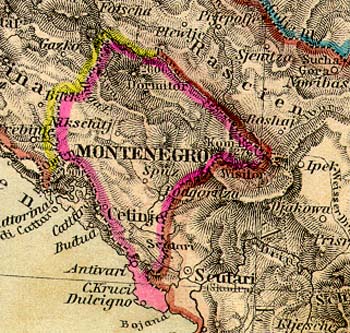 |
|
 |
|
Pancic’s botanical journey throughout Montenegro started in July 1873 in Kotor where he came from Trieste. In his letter to V.Janki, he complains that he, owing to the great draught, could do little collecting only Secale dalmaticum , Linaria dalmatica and Chamaepeuce stricta. From Kotor he went to Cetinje from where he made a short outing to Mt. Lovcen where he found only several specimens of Senecio Visianianus Papaf., Heliosperma Tommasinii, Potentilla speciosa and Prunus prostrata. He also reported that in flower were Amphoicarpus Neumayeri, Chrysanthemum coronopifolium, Alsine Arduini and one specimen of Hieracium, supposed to have been a piliferum. The journey from Cetinje to Mt.Durmitor took him full five days and another four to climb its two summits. Pancic was amazed with the summits, meadows and many lakes of Durmitor. From Mt. Durmitor he descended southwards to Mt.Kom. During that journey he made a short stopover in Mt.Javorje, and found it an interesting mountain deserving to be surveyed for at least two days. From there he descended to the Moraca river Valley and to the Moraca monastery. Over a couple of days he found only several plant species of which, as he said, one specimen of Hieracium might have been new. From the monastery of Moraca he went eastwards, towards Kolašin and then along the Tara /REKA ili PL to Mt.Kom. He camped for two days at the foot of Kom but during one of these two days he climbed its second highest summit. In his opinion, among collected plants, one specimen of Valeriana and one of Saponaria, might have been new to science. Pancic found that, Mt Kom is not so beautiful as Mt Durmitor given that at greater heights, due to loose calcareous ground, plants cannot root well and there are no lakes since slopes are steep and with screes. After leaving Kom, it took him two very dull days to reach Zeta region, through Vasojevic and Bratonožica. He continued his journey next day to the northern part of Skadar Lake (Gornje Blato) and reached the town of Vir by boat. There he found common hydrophytes. It took him another day to climb Mt. Sutorman, where unfortunately, almost all plants were dry. Still he managed to collect the remnants of some plants in Mali Lonac, stone cone of Sutorman , and to return late into the night to Vir. During the next two days he reached Cetinje, exactly 25 days after he had commenced his journey. After a short rest he sent heavier things to Kotor and headed for Grahovo through Ceklica. On this 2-day trip, in addition to other plants, he found Centaurea crocea for which he thought that it might have been new to science as well as Briza racemosa which is not common for this latitude. From there he went to Bjela Gora and further and found out that plants in Mts. Bjela Gora and Vucji Zub and to some extent Mt.Orjen are completely dried up. At the end of this journey he found one doubtful species Pinus, probably P.leucodermis, which lacked the characteristic colour of branch bark. By this, as Pancic himself said, he completed his touring of Montenegro. Through Krivošaj he descended to Risan and from there by boat to Kotor from where he returned to Trieste. Despite unfavourable conditions (dry year), prevailing during this trip, Pancic collected abundant floristic material (about 1,298 species). As new to science and flora of Montenegro, he described the following species:
1. Heliosperma macrantha Panc. (Komovo region)
2. Geranium oreades Panc. (Durmitor, Komovi)
3. Valeriana bertiscea Panc. (Komovi)
4. Carduus ramosissimus Panc. (Durmitor)
5. Sonchus pallescens Panc. (the surrounding of Cetinje)
6. Hieracium thapsoides Panc. (Monastery of Moraca)
7. Hieracium naeglianum Panc. (Komovi)
8. Hieracium myriocephalum Panc. (Black Lake in Mt.Durmitor)
9. Verbascum leptocladum Panc. (the Moraca Valley)